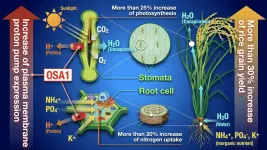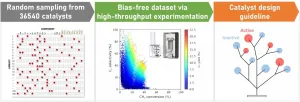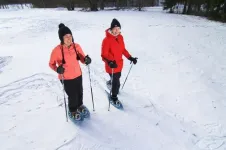Flower diversity may mitigate insecticide effects on wild bees
Research team led by the University of Göttingen emphasizes the benefits of diversifying flower resources
2021-02-03
(Press-News.org) A higher diversity of flowering plants increases the breeding success of wild bees and may help compensate for the negative effects of insecticides. This is what researchers from the Universities of Göttingen and Hohenheim, as well as the Julius Kühn Institute, have found in a large-scale experimental study. The results have been published in the scientific journal Ecology Letters.
In their experiment, the researchers investigated how successfully the wild bee Osmia bicornis (red mason bee) reproduced. Red mason bees are important for both ecological and economic reasons. The wild bees were experimentally kept in more than 50 large enclosure cages with flower mixtures of varying wild plant diversity and insecticide-treated oilseed rape. Subsequently, the reproductive success of the wild bees, as measured by the number of their brood cells and emerged offspring, was investigated over several months.
The research team found that the number of cells that the wild bees created for their offspring where species-rich flowering mixtures were available was twice that of wild bees where only oilseed rape was available. The reproductive success of the wild bees, which have to supply their offspring with pollen and nectar, increased both in cages with a large diversity of flowering plants and where there were particularly important plant species. In contrast, if oilseed rape treated with clothianidin (from the neonicotinoid class of insecticides), was available to the bees, this had a negative effect on their reproductive success. However, this negative effect of the insecticide only occurred in cages with oilseed rape monocultures, which suggests that such effects can be mitigated by alternative food resources from species-rich flowering mixtures.
The study shows that both the diversity of flowering plants and exposure to insecticides significantly influence the reproductive success of wild bees, and shows that a high diversity of flowering plants could compensate for the negative effects of insecticides. "One possible explanation is that bee larvae benefit from additional nutrients, and are exposed to fewer insecticides, when the pollen of other plant species besides oilseed rape is available to them," explains Felix Klaus, first author of the study and PhD student in the Agroecology Group at Göttingen University. "Our results emphasise the important role of species-rich resources of flowers for wild bees," adds Professor Ingo Grass, head of the Department of Ecology of Tropical Agricultural Systems at the University of Hohenheim. "If sufficiently diverse flowers are available in the agricultural landscape, this could counteract the negative effects of monocultures and insecticides," says Professor Teja Tscharntke, Head of the Agroecology Group at Göttingen University.
INFORMATION:
Original publication: Felix Klaus et al. (2021): Floral resource diversification promotes solitary bee reproduction and may offset insecticide effects - evidence from a semi-field experiment. Ecology Letters. DOI: 10.1111/ele.13683 or here to see the paper: https://onlinelibrary.wiley.com/doi/full/10.1111/ele.13683
Contact:
Felix Klaus
University of Göttingen
Faculty of Agricultural Sciences
Department of Crop Sciences - Agroecology Group
Grisebachstraße 6, 37077 Göttingen
Tel: +49 (0)551 3922359
Email: felix.klaus@uni-goettingen.de
https://uni-goettingen.de/en/74726.html
Professor Teja Tscharntke
University of Göttingen
Faculty of Agricultural Sciences
Department of Crop Sciences - Agroecology Group
Tel: +49 (0)551 399209
Email: ttschar@gwdg.de
Professor Ingo Grass
University of Hohenheim
Department of Ecology of Tropical Agricultural Systems
Institute of Agricultural Sciences in the Tropics
Garbenstraße 13, 70599 Stuttgart
Tel: +49 (0) 711 459-22385,
Email: ingo.grass@uni-hohenheim.de
https://agroecology.uni-hohenheim.de/en/prof-grass
[Attachments] See images for this press release:

ELSE PRESS RELEASES FROM THIS DATE:
2021-02-03
Researchers in Costa Rica have found that some bacteria on the skin of amphibians prevent growth of the fungus responsible for what has been dubbed 'the amphibian apocalypse'.
Published in the journal Microbiology, the research identified a number of bacteria which could growth of the fungus Batrachochytrium dendrobatidis (Bd). One particularly dangerous strain of the fungus, called BdGPL-2, is responsible for mass amphibian die-offs around the world.
The fungus infects the skin of amphibians, breaking down the cells. As amphibians breathe and regulate water through their skin, infection is often deadly. It is believed that almost 700 species of amphibian are vulnerable to the ...
2021-02-03
A group of scientists led by Drs Toshinori Kinoshita and Maoxing Zhang (Institute of Transformative Bio-Molecules,Nagoya University, Japan) and Dr Yiyong Zhu (Jiangsu Collaborative Innovation Center for Solid Organic Waste Utilization, Nanjing Agricultural University, China) have developed a method which, by increasing the number of a plasma membrane proton pump gene in rice, simultaneously increases nutrient uptake through the roots and stomatal opening, thus increasing the yield of paddy field grown rice by over 30%.
In their previous research, the group had found that the plasma membrane proton pump played an important role in influencing stomatal opening. When they created a variant of rice with an overexpression of a particular plasma membrane proton pump gene, they found ...
2021-02-03
Modern-day robots are often required to interact with humans intelligently and efficiently, which can be enabled by providing them the ability to perceive touch. However, previous attempts at mimicking human skin have involved bulky and complex electronics, wiring, and a risk of damage. In a recent study, researchers from Japan sidestep these difficulties by constructing a 3D vision-guided artificial skin that enables tactile sensing with high performance, opening doors to innumerable applications in medicine, healthcare, and industry.
Robots have come a long way since their original inception for high-speed automation. Today, robots can be found in a wide variety of roles in medicine, rehabilitation, agriculture, and marine navigation. Since a ...
2021-02-03
Modern immunotherapeutic anti-cancer drugs support a natural mechanism of the immune system to inhibit the growth of cancer cells. They dock onto a specific receptor of the killer cell and prevent it from being switched off by the cancer cells. This is a complex molecular process, which is known but has not yet been fully understood. In a molecular dynamics study conducted by the group led by medical information scientist Wolfgang Schreiner and gynaecologists Heinz Kölbl and Georg Pfeiler from MedUni Vienna, working with biosimulation expert Chris Oostenbrink ...
2021-02-03
What are the reasons for such a contrast in outcomes? A scientist team led by the Leibniz Institute for Zoo and Wildlife Research (Leibniz-IZW) has now analysed the humoral innate immune defence of European greater mouse-eared bats to the fungus. In contrast to North American bats, European bats have sufficient baseline levels of key immune parameters and thus tolerate a certain level of infection throughout hibernation. The results are published in the journal "Developmental and Comparative Immunology".
During infections caused by Pseudogymnoascus destructans (Pd), North American bats arouse frequently from ...
2021-02-03
To date, research in the field of combinatorial catalysts has relied on serendipitous discoveries of catalyst combinations. Now, scientists from Japan have streamlined a protocol that combines random sampling, high-throughput experimentation, and data science to identify synergistic combinations of catalysts. With this breakthrough, the researchers hope to remove the limits placed on research by relying on chance discoveries and have their new protocol used more often in catalyst informatics.
Catalysts, or their combinations, are compounds that significantly lower the energy required to drive chemical reactions to completion. In the field of "combinatorial catalyst design," the requirement of synergy--where one component ...
2021-02-03
Life changes influence the amount of physical activity in a person, according to a recent study by the University of Jyväskylä. The birth of children and a change of residence, marital status and place of work all influence the number of steps of men and women in different ways. For women, having children, getting a job and moving from town to the countryside reduce everyday exercise.
A study conducted by the Faculty of Sports & Health Sciences found that the birth of the first child significantly reduces the number of everyday steps in women. As children grow, women's aerobic steps, in turn, increase. Although the birth of children did not have a statistically significant effect on the number of steps in men, changes were also observed ...
2021-02-03
Use of waste heat contributes largely to sustainable energy supply. Scientists of Karlsruhe Institute of Technology (KIT) and T?hoku University in Japan have now come much closer to their goal of converting waste heat into electrical power at small temperature differences. As reported in Joule, electrical power per footprint of thermomagnetic generators based on Heusler alloy films has been increased by a factor of 3.4. (DOI: 10.1016/j.joule.2020.10.019)
Many technical processes only use part of the energy consumed. The remaining fraction leaves the system ...
2021-02-03
In the race to stop the spread of COVID-19, a three-layer cloth mask that fits well can effectively filter COVID particles, says a group of UBC researchers.
After testing several different mask styles and 41 types of fabrics, they found that a mask consisting of two layers of low-thread-count quilting cotton plus a three-ply dried baby wipe filter was as effective as a commercial non-surgical mask at stopping particles--and almost as breathable.
The cloth masks filtered out up to 80 per cent of 3-micron particles, and more than 90 per cent of 10-micron particles.
"We focused on particles larger than one micron because these are likely most important to COVID-19 transmission," explains researcher Dr. Steven Rogak, a professor of mechanical engineering who ...
2021-02-03
The genus Ficus (figs) and their agaonid pollinating fig wasps are a classic example of coevolution. It represents perhaps the most extreme and ancient (about 75 million years) obligate pollination mutualism known.
Previous studies have suggested that pollinator host-switching and hybridization existed in some fig taxa with genetic evidence based on relatively few genes. However, those cases were mainly treated as rare exceptions, and strict-sense coevolution was still treated as the dominate coevolution model for the codiversification of this "extreme" obligate pollination system with high species richness.
Together with colleagues from 11 institutions from home and abroad, researchers from the Xishuangbanna Tropical Botanical ...
LAST 30 PRESS RELEASES:
[Press-News.org] Flower diversity may mitigate insecticide effects on wild bees
Research team led by the University of Göttingen emphasizes the benefits of diversifying flower resources








